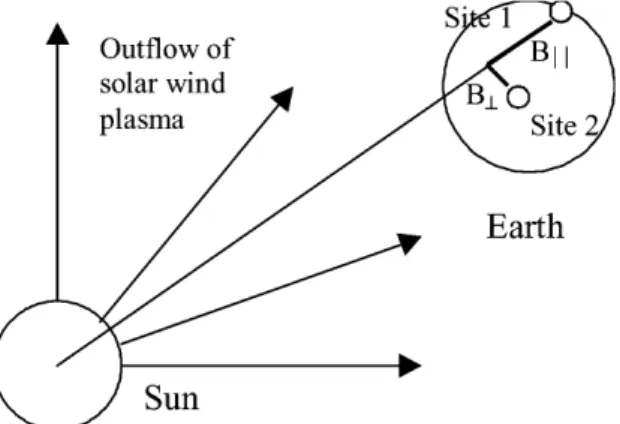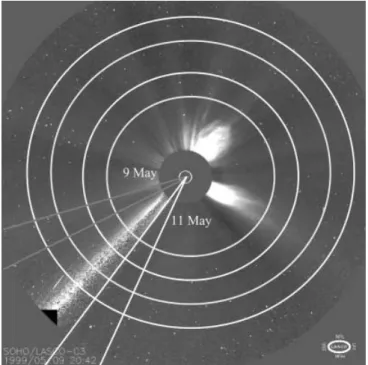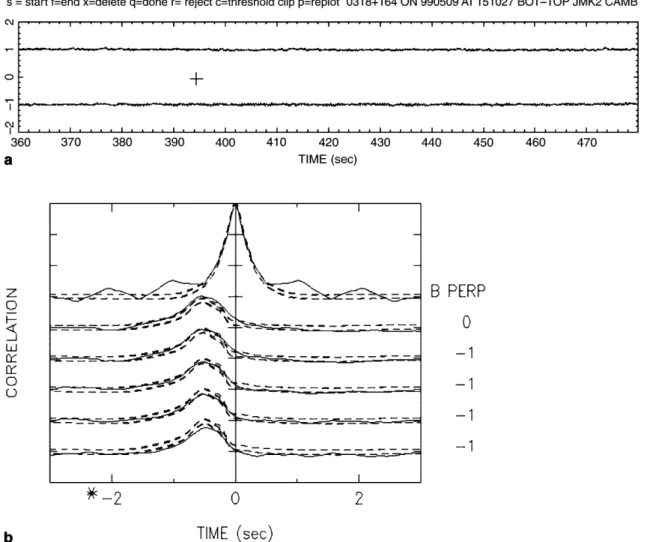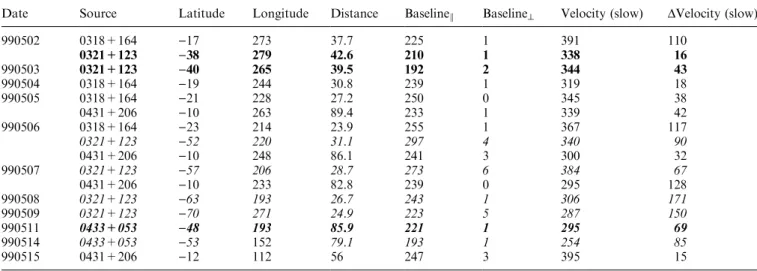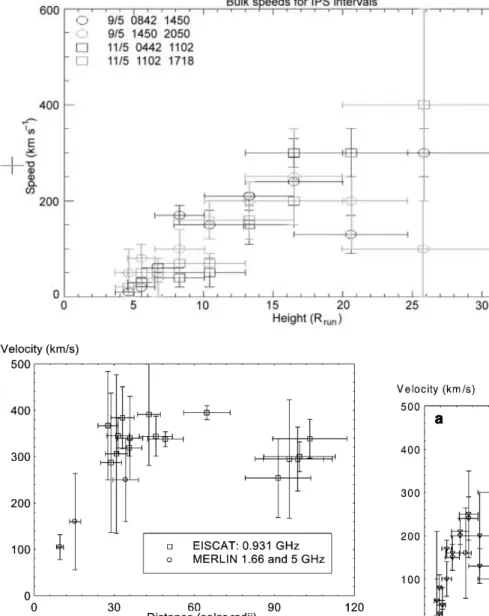HAL Id: hal-00316752
https://hal.archives-ouvertes.fr/hal-00316752
Submitted on 1 Jan 2000
HAL is a multi-disciplinary open access
archive for the deposit and dissemination of sci-entific research documents, whether they are pub-lished or not. The documents may come from teaching and research institutions in France or abroad, or from public or private research centers.
L’archive ouverte pluridisciplinaire HAL, est destinée au dépôt et à la diffusion de documents scientifiques de niveau recherche, publiés ou non, émanant des établissements d’enseignement et de recherche français ou étrangers, des laboratoires publics ou privés.
Simultaneous interplanetary scintillation and optical
measurements of the acceleration of the slow solar wind
A. R. Breen, S. J. Tappin, C. A. Jordan, P. Thomasson, P. J. Moran, R. A.
Fallows, A. Canals, P. J. S. Williams
To cite this version:
A. R. Breen, S. J. Tappin, C. A. Jordan, P. Thomasson, P. J. Moran, et al.. Simultaneous inter-planetary scintillation and optical measurements of the acceleration of the slow solar wind. Annales Geophysicae, European Geosciences Union, 2000, 18 (9), pp.995-1002. �hal-00316752�
Simultaneous interplanetary scintillation and optical measurements
of the acceleration of the slow solar wind
A. R. Breen1, S. J. Tappin2, C. A. Jordan3, P. Thomasson3, P. J. Moran1, R. A. Fallows1, A. Canals1,
P. J. S. Williams1
1University of Wales, Aberystwyth, Ceredigion SY23 3BZ, Wales, UK 2University of Birmingham, Edgbaston, Birmingham, UK
3The University of Manchester, Jodrell Bank Observatory, Cheshire, UK Received: 21 February 2000 / Revised: 13 June 2000 / Accepted: 21 June 2000
Abstract. Simultaneous observations of the slow solar wind o the southeast limb of the Sun were made in May 1999 using optical measurements from the C2 and C3 LASCO coronagraphs on board the SOHO spacecraft and radio-scattering measurements from the MERLIN and EISCAT facilities. The observations show the slow solar wind accelerating outwards from 4.5 solar radii (R), reaching a ®nal velocity of 200±300 km s)1by 25±
30 R. The acceleration pro®le indicated by these results is more gentle than the average pro®le seen in earlier LASCO observations of larger scale features, but is within the variation seen in these studies.
Key words: Interplanetary physics (solar wind plasma; sources of the solar wind; instruments and techniques)
1 Introduction
1.1 Interplanetary scintillation observations
Observations of interplanetary scintillation (IPS), in which the diraction pattern cast across the Earth when a distant compact radio source is observed through the solar wind have been used as a ¯ow tracer in the solar wind for over 35 years (e.g. Hewish et al., 1964; Dennison and Hewish, 1967; Armstrong and Coles, 1972). Provided that the phase changes introduced into the incident radio waves are small (the condition of weak scattering) it is possible to treat contributions to the observed scintillation pattern from dierent parts of the line-of-sight to the source separately (e.g. Coles, 1995; Grall et al., 1996; Breen et al., 1996b). As the ray-path from the source to the antenna moves closer in to the Sun, the phase changes become larger and the amplitude of the scintillation pattern increases until the
inner limit of weak scattering is reached. Inside this limit, in the ``strong scattering'' regime where the phase changes introduced by scattering are large, the contri-butions from dierent regions of the ray-path do not combine as a simple weighted linear sum, and it becomes very dicult to accurately determine the contributions of dierent regions of the ray-path to the observed scintillation pattern (e.g. Hewish, 1989; Grall, 1995). The distance from the Sun for the transition from weak to strong scattering depends on the frequency of the radio waves received: for EISCAT observing at 0.93 GHz, the transition takes place at 25±30 solar radii (R) in the slow wind; for MERLIN (Thomasson, 1986) observing at 5 GHz, the transition lies below 7 R, though it is to be noted that the power radiated by most of the strong astronomical radio sources falls o towards higher frequencies, so that fewer ``good'' IPS sources are available at higher frequencies. A combina-tion of high-frequency observacombina-tions covering the region close to the Sun and lower-frequency observations covering the outer regions, with overlapping ®elds-of-view, is ideal. A schematic diagram of the geometry of an IPS observation is given in Fig. 1.
The ®rst IPS observations using the EISCAT facility at a frequency of 0.93 GHz were made in 1982 (Bourgois et al., 1985) and a regular series of measurements of solar wind velocity have been made every summer since 1993. IPS observations have been made with MERLIN by Rickett (1992), initially in 1989 at 1.658 GHz using several baselines up to 127 km in length, and later in 1992 using the upgraded MERLIN incorporating the new Cam-bridge antenna which provides baselines of up to 217 km. The results of these observations were encouraging, and provided the impetus for the combined programme of EISCAT and MERLIN observations run in May 1999. 1.2 White-light observations
One of the aims of the coronal instruments on the SOHO spacecraft was the determination of the acceler-ation pro®le of the solar wind (Domingo et al., 1995).
Correspondence to: A. R. Breen e-mail: azb@aber.ac.uk
Of the imaging coronal instruments, the large-angle spectroscopic coronagraph (LASCO, described by Brue-ckner et al., 1995) is ideal for investigating out¯ow velocities from the inner corona out to distances of 25± 30 R. Various LASCO studies (Sheeley et al., 1997; Tappin and Simnett, 1998; Tappin et al., 1999) have investigated the speed of identi®able features as they propagated out through the ®elds-of-view of the two LASCO coronagraphs. The small discrete ``knots'' or ``blobs'' studied by Sheeley et al. (1997) showed evi-dence of continuous acceleration from around 2 solar radii (R) out to beyond 20 R. The large-scale features, coronal mass ejections, studied by Tappin and Simnett (1998) were somewhat dierent. Some showed contin-uous acceleration, but the majority either moved at constant velocity or underwent a sudden acceleration at distances between 5 and 8 R. This behaviour is similar to that reported by Srivastava et al. (1999).
Sheeley et al. (1997) derived ¯ow speeds by assuming that the features they studied were drifting at the background solar wind speed ``like leaves in a stream''. This assumption can be made with more certainty if smaller features are studied, and particularly if the velocity pro®les of features on dierent scales are compared. Tappin et al. (1999) considered very small-scale features in LASCO data and derived out¯ow velocities by calculating the cross-correlation function of white-light intensity at two radial distances from the limb of the Sun, a method analogous to the 2-site IPS technique (but see Tappin et al., 1999 for a discussion of the dierences between the two methods). The results indicated that the slow solar wind had reached its cruising speed by 25±30 R, with most of the acceleration taking place inside 10±15 R. Breen et al. (2000) com-pared the velocity of small-scale variations in intensity
observed in the fast solar wind with velocities obtained from EISCAT IPS measurements, but unfortunately the signal-to-noise ratio in the outer part of the LASCO ®eld-of-view was too low for a direct comparison of velocities derived by the two techniques at the same radial distance. The observations made by Tappin and Simnett (1998), Sheeley et al. (1997), Tappin et al. (1999), Srivastava et al. (1999) and Breen et al. (2000) therefore cover four entirely dierent ranges of irregu-larity scale, from in excess of 100 000 km to around 100 km. In this study LASCO, MERLIN and EISCAT data from overlapping ®elds-of-view were compared for three days in May 1999. The scale sizes of the irregu-larities ranged from ~10 000 km for the LASCO fea-tures to ~100 km for the irregularities observed by EISCAT IPS and ~60 km for those observed at 5 GHz by MERLIN.
2 Observations
The observations discussed were made from EISCAT, MERLIN and LASCO between 2 and 15 May, 1999 and were co-ordinated so that the dierent instruments observed ¯ow along similar stream lines of ¯ow (within 10° latitude and lying o the same limb).
2.1 LASCO observations
The LASCO (Large-Angle Spectroscopic Coronagraph) instruments observed the white-light intensity in the solar corona o the southeast limb of the Sun for 12 h per day on 9 and 11 May, 1999, producing an image from the C2 and C3 coronagraphs every 12 min. This was the ®nest time resolution possible when using C2 and C3 together, because of limitations in the data transfer rate from SOHO to Earth (Plunkett, private communication, 1999). The results were divided into two overlapping distance ranges from the Sun (Fig. 2) and cross-correlated (using the analysis technique de-scribed by Tappin et al., 1999) to obtain estimates of the ¯ow speed. The observations from each day were divided into two 6-h intervals to provide independent estimates of slow speed.
2.2 MERLIN observations
The strong radio source 0318+164 (CTA-21), with its small angular size and well-studied structure, is an ideal source for high-frequency IPS observations of the innermost regions of the solar wind. Lying o the southeast limb of the Sun in early May 1999 and moving closer to the Sun and towards higher latitudes with time, it had ray-paths to the Earth which reached their closest approach to the Sun on 12 May, 1999.
Time was allocated for MERLIN observations on three days (4, 9 and 11 May, 1999). 0318+164 was observed on all three days for approximately 2.5 hours per day. The observations are summarised in Table 1.
Fig. 1. Schematic diagram of a two-station observation of interplan-etary scintillation, viewed from the direction of the radio source (normally a Quasar). The maximum cross-correlation between the scintillations observed at the two sites occurs when the baseline between the two receiving stations is parallel to the weighted average direction of ¯ow of the solar wind across the ray-path (close to radially outwards from the Sun), and at a time-lag determined by the drift velocity of the scintillation pattern between the two ray-paths (e.g. Moran et al., 1998). The baselines radial and tangential to the Sun-Earth direction in the plane of the sky are shown as B||and B^ respectively
Observations were also made of a second radio source, 0321+123, which lay further out from the Sun o the same limb as 0318+164, but unfortunately these proved to be too weak to produce useful scintillation measure-ments. 3C84 (0316+413) and 0552+398, at suciently large distances from the Sun that the degree of scintil-lation should have been negligible were observed for calibration purposes.
The observations on 4 May were made using the Cambridge and Knockin telescopes of MERLIN, oper-ating at a central frequency of 1.66 GHz, a single polarisation (left circular) of equivalent band width 10 MHz being sampled at 100 Hz. On 9 and 11 May, the Cambridge and Jodrell Bank Mk2 telescopes were used at a central frequency of 5 GHz. Once again the detected equivalent band width was 10 MHz and the signals were sampled at 100 Hz. However, although only the left-circular polarisation was recorded from the Cambridge telescope, both left- and right-circular po-larisations were recorded from the Mk2 telescope Ideally, both polarisations would have been recorded
at all sites. However, in order to preserve the total power information essential for IPS measurements during the microwave link signal transfer from the outstation sites at Cambridge and Knockin to Jodrell Bank the signals had to be frequency modulated onto the links, which restricted them to a single 10 MHz polarisation band. In future experiments we intend to record data locally at each site, which will permit a wider band width and sampling of both polarisations.
Although the Cambridge data were noisy, with signi®cant quasi-periodic interference, the scintillation pattern as the solar wind ¯owed across the ray-path from 0318+164 was detectable and good correlation was observed between the measurements at the two sites (Fig. 3). Good data were obtained from Knockin on 4 May, 1999, and from the Jodrell Bank Mk.2 telescope on 9 and 11 May, 1999.
The baselines available from MERLIN are signi®-cantly shorter than those of EISCAT (Tables 1, 2), but the velocity resolution is still adequate when the solar wind across the ray-path is dominated by a single stream, as was the case for the observations of 0318+164 during early May 1999.
2.3 EISCAT observations
EISCAT made observations of IPS o the southeast limb of the Sun every day from 2 May, 1999, to 15 May, 1999. These observations are summarised in Table 2. The data were received on one polarisation over a 8 MHz band width at the Tromsù and SodankylaÈ sites (7.5 MHz at the Kiruna site), centred on 931.5 MHz. Initial sampling was at 10 kHz, with the data subse-quently averaged to give a sample every 0.01 s (e.g. Breen et al., 1996a). Together with the MERLIN and LASCO observations, the EISCAT results extended the measured pro®le of slow wind velocity out to beyond 90 R. Mean velocities throughout the distance range covered by EISCAT were in the range 250±380 km s)1.
3 Results
The LASCO results were dominated by slow ¯ow throughout this period, though a small amount of fast ¯ow was detectable. The IPS results from MERLIN and EISCAT also clearly showed clear slow ¯ow with a weak fast component originating from a coronal hole lying on the anti-Earthward side of the Sun. This was as expected, as the observations lay above a conspicuous
Fig. 2. Schematic diagram showing the regions of the LASCO ®eld-of-view used to estimate ¯ow speeds on 9 and 11 May, 1999, overlaid on a LASCO C3 image from 2042 UT on 9 May, 1999. The support for the occulting disc is visible at about 45° South o the east limb. The regions observed were PA 110±125 on 9 May and PA 145±160 on 11 May
Table 1. MERLIN IPS observations during the slow wind velocity study interval. Latitudes given are heliocentric, longitudes are Carrington and distances are in solar radii: these co-ordinates are
given for the point of closest approach of the IPS ray-path to the Sun. Baseline lengths are in km, velocities are in km s)1
Date Source Latitude Longitude Distance Baselinek Baseline^ Velocity DVelocity
990504 0318+164 )19 242 30.8 152 0.8 316 25
990509 0318+164 )36 166 13.6 154 0.2 169 84
east-limb streamer (Fig. 2). Projecting the IPS ray-paths back to 2.5 R using a simple constant-velocity ballistic model shows that the great majority of ¯ow across the ray-paths originated above the bright corona. A typical example (MERLIN observation of 0318+164 on 9 May, 1999) is shown as Fig. 4.
The LASCO velocities are shown in Fig. 5. The large error bars at heliocentric distances beyond 25 R are a result of the poor signal-to-noise ratio in the outer regions of the LASCO ®eld-of view, which are caused by the low electron densities (and thus poor contrast between the white-light corona and the background) at these distances.
Figure 6 shows the velocities derived from MERLIN and EISCAT IPS observations on 4, 9 and 11 May, 1999. There is considerable scatter between data points, which is probably a result of dierent streams of slow wind lying across the ray-paths of the dierent observations, but the overall trend, with acceleration from velocities of 100±200 km s)1 at distances of 9±11 R to 250±
300 km s)1 by 30 R, is clear. The velocities observed
on 4 May, 1999, at 31 R by MERLIN (at 1.66 GHz) and
EISCAT (at 931.5 MHz) agree to within the uncertain-ties in the measurements. There is good reason to believe that a signi®cant proportion of these uncertainties re¯ect real, physical dierences in the velocities of dierent streams of slow wind across the ray-paths.
4 Slow wind velocity pro®les
Figure 7 shows a plot of the velocities derived from all of the observations made by LASCO, MERLIN and EISCAT between 2 and 15 May, 1999. There is very good overall agreement between the LASCO and IPS velocities, indicating that the irregularities observed by the two techniques are drifting at the same speed. As the scale sizes of the irregularities observed by LASCO and IPS are so dierent (~10 000 km for LASCO, ~100 km for IPS) this suggests that the irregularities are drifting at the background ¯ow speed.
The observations made on 4, 9 and 11 May covered dierent latitudes and longitudes on the Sun, so any direct comparison of results from dierent distances on
Fig. 3. a Raw data from the MERLIN receiving stations at Jodrell Bank (average of scintillations in both polarisations) and Cambridge, 9 May, 1999 1507 UT to 1509 UT. b Observed (solid lines) and ®tted auto- and cross-correlation functions for 75 min of data centred on
1540 UT. The observed scintillation is weak but clearly detectable, and model ®tting suggests that the data is best described as dominated by slow ¯ow at an average speed of 160 km s)1, with a signi®cant degree of variation (100 km s)1)
dierent days can be misleading. Figure 8 shows the velocities measured along the stream lines of ¯ow observed by MERLIN and LASCO on 9 May at 36° South (Fig. 8a) and 11 May at 60° South (Fig. 8b).
The velocities determined from LASCO and IPS measurements agree well, and on both days the accel-eration region of the slow wind appears to lie between 5 and 20 R. This is within the variation of the velocity pro®les for large-scale drifting structures (~100 000 km scale size) determined by Sheeley et al. (1997), although the 1999 IPS/LASCO results indicate rather lower speeds than the average of the Sheeley et al. (1997) pro®les. The Sheeley et al. (1997) pro®les showed a large
degree of variation, so that this dierence does not imply inconsistency between the studies. The slow solar wind is known to be highly variable in density and velocity so it would not be surprising if dierent streams had slightly dierent acceleration pro®les too.
5 Conclusions
The results of these simultaneous overlapping optical and IPS observations of the slow wind are most satisfactory. There is good agreement between the velocities observed in the same regions by LASCO,
Table 2. EISCAT IPS observations during the slow wind velocity study interval. Latitudes given are heliocentric, longitudes are Carrington and distances are in solar radii: these co-ordinates are given for the point of closest approach of the IPS ray-path to the Sun. Velocities are in km s)1. Observations shown in normal type lie along similar stream lines of ¯ow to that observed using MERLIN on 4 May, 1999, observations shown in bold type lie along similar
stream lines of ¯ow to that observed using MERLIN on 9 May, 1999, and observations shown in italic type lie along similar stream lines of ¯ow to that observed with MERLIN on 11 May, 1999. The observation shown in italic bold type lies on a stream line between those observed by MERLIN on 9 and 11 May, 1999, but is included as it covers a distance and latitude region otherwise unrepresented in the LASCO/MERLIN/EISCAT dataset
Date Source Latitude Longitude Distance Baselinek Baseline^ Velocity (slow) DVelocity (slow)
990502 0318+164 )17 273 37.7 225 1 391 110 0321+123 )38 279 42.6 210 1 338 16 990503 0321+123 )40 265 39.5 192 2 344 43 990504 0318+164 )19 244 30.8 239 1 319 18 990505 0318+164 )21 228 27.2 250 0 345 38 0431+206 )10 263 89.4 233 1 339 42 990506 0318+164 )23 214 23.9 255 1 367 117 0321+123 )52 220 31.1 297 4 340 90 0431+206 )10 248 86.1 241 3 300 32 990507 0321+123 )57 206 28.7 273 6 384 67 0431+206 )10 233 82.8 239 0 295 128 990508 0321+123 )63 193 26.7 243 1 306 171 990509 0321+123 )70 271 24.9 223 5 287 150 990511 0433+053 )48 193 85.9 221 1 295 69 990514 0433+053 )53 152 79.1 193 1 254 85 990515 0431+206 )12 112 56 247 3 395 15
The large error bars in the velocities determined from observations of 0431+206 at large distances from the Sun are caused by the low scintillation power received when the ray-path to the source does not pass close to the Sun. The large uncertainties in velocities de-termined from observations from inside 28 R may arise from real
dierences in ¯ow speeds in adjacent streams of slow wind, or may be a result of uncertainties in the modelling process as the ray-path approaches strong scattering. Further analysis is necessary before the contributions of these sources of uncertainty can be separated
Fig. 4. Ray-path for the MERLIN observation of 0318+164 on 9 May, 1999, projected back ballistically to 2.5 R and overlaid on a white-light map constructed from east-limb LASCO C2 data. Only a very small portion of the ray-path lies above a coronal hole, which is
consistent with the observation being dominated by slow ¯ow. The white-light map covers Carrington longitudes from )180° to 180° and heliographic latitudes from 90° South to 90° North, with the centre of the map at 0° heliographic latitude and 0° Carrington longitude
Fig. 5. Slow wind velocities measured by LASCO on 9 and 11 May, 1999. The large error bars for measurements outside 25 R are a result of the low signal-to-noise ratio in the out-ermost regions of the LASCO ®eld-of-view
Fig. 6. Velocities determined from EISCAT h and MERLIN s IPS observations o the southeast limb of the Sun between 2 and 15 May, 1999
Fig. 7. Combined plot showing LASCO and IPS velocities o the southeast limb of the Sun between 2 and 15 May, 1999
Fig. 8. a Solar wind velocities measured by LASCO, MERLIN and EISCAT along the stream lines of ¯ow observed by LASCO and MERLIN on 9 May, 1999. b As Figure 8a but showing velocities measured by LASCO, MERLIN and EISCAT along the stream lines observed by LASCO and MERLIN on 11 May, 1999
MERLIN and EISCAT, considering scale sizes of between 10 000 km and 100 km. Together with the similar results of Sheeley et al. (1997) considering ``knots'' and ``blobs'' of plasma with scale sizes of ~100 000 km, and of Tappin and Simnett (1998) and Srivastava et al. (1999) considering slow-rising CMEs with larger scale sizes, this strongly suggests that density irregularities of very dierent scale sizes drift at the same speed. This, in turn, supports the Sheeley et al. (1997) picture of density irregularities drifting with the back-ground plasma ¯ow ``like leaves in a stream''.
The observations made in May 1999 suggest that the slow solar wind begins to accelerate somewhat inside of 4±5 R and reaches its cruising speed by 20±30 R, with most acceleration taking place between 10 and 20 R. This is very dierent from the fast wind, which reaches its cruising velocity inside 15 R (Grall et al., 1996; Breen et al., 2000). There is considerable scatter in the mea-sured velocities, and this may re¯ect dierences in speed between adjacent streams of slow wind. The slow wind is known to be highly variable in velocity and density outside 30 R (e.g. Breen et al., 1996b; Axford and McKenzie, 1997) and we would expect these variations to be even more marked close to the Sun, when stream-stream interaction will not have had any signi®cant smoothing eect. The variations seen between observa-tions made on 9 and 11 May, 1999, at 36 10° and 60 10° south latitudes tend to support this view.
The uncertainties in velocities estimated from IPS measurements re¯ect variation in ¯ow speed across the ray-path. The large uncertainties in measurements made close to the Sun suggest that inside 25 R there is considerable variation in slow wind speed. The very slow lower velocity limits and low coecients of cross-correlation seen in the innermost MERLIN observa-tions suggest that quasi-static plasma may be present in the ray-path, coronal streamers are known from LAS-CO images (Fig. 2) to extend out beyond 8 R, so it is possible that very low-speed ¯ow in the body of the streamer may contribute to the wide variation in ¯ow speeds. More observations will be required to con®rm or deny this supposition, and we intend to carry out a further sequence of co-ordinated LASCO-MERLIN-EISCAT measurements in May 2000.
The very good agreement between the drift velocities observed for irregularities of a wide range of scale sizes is an important result. The observations do not explicitly con®rm that the irregularity drift velocity is the same as the background ¯ow speed (it is unlikely that anything other than in-situ measurements could unambiguously measure the bulk ¯ow speed in this region), but the agreement seen between the drift velocities of irregular-ities of such dierent scale sizes does suggest that these features are indeed drifting with the background ¯ow. The slow and variable nature of the acceleration pro®le observed is very dierent to that seen in the fast wind, and will provide valuable information for modellers seeking to understand the origin and acceleration of the slow solar wind.
A small amount of the ray-paths of all of these observations above dark regions in the white-light maps,
and LASCO, MERLIN and EISCAT all detected small proportions of fast ¯ow. More analysis is required to accurately determine the precise velocities in these regions, and we hope to present these results in a future paper.
Acknowledgements. We would like to thank the director and sta of EISCAT for the 0.93 GHz IPS data used in this study. EISCAT is supported by the scienti®c research councils of Finland, France, Germany, Japan, Norway, Sweden and the U.K. MERLIN is a National Facility operated by the University of Manchester on behalf of PPARC. We would like to thank the Director and sta of Jodrell Bank for making available necessary additional equipment. The LASCO white-light data was made available by the LASCO consortium. SOHO is an ESA/NASA joint mission. We would like to give particular thanks to B.J. Rickett and W.A. Coles for making their experimental programmes, analysis routines and expertise available to us. Three of us (ARB, RAF, PJM) were supported by PPARC during the period when this work was carried out. AC was supported by the University of Wales.
Topical Editor M. Lester thanks R. Schwenn and G. Woan for their help in evaluating this paper.
References
Armstrong, J. A., and W. A. Coles, Analysis of three-station interplanetary scintillation data, J. Geophys. Res., 77, 4602± 4610, 1972.
Axford, W. I., and J. F. McKenzie, The solar wind, in Cosmic winds and the heliosphere, Eds. Jokipii, J. R., C. P. Sonnett, and M. S. Giampapa, University of Arizona Press, 1997.
Bourgois, G., W. A. Coles, G. Daigne, J. Silen, T. Turenen, and P. J. S. Williams, Measurements of solar wind velocity using EISCAT, Astron. Astrophys., 144, 452±462, 1985.
Breen, A. R., W. A. Coles, R. R, Grall, U. P. Lùvhaug, J. Markkanen, H. Misawa, and P. J. S. Williams, EISCAT observations of interplanetary scintillation, J. Atmos. Terr. Phys., 58, 507±519, 1996a.
Breen, A. R., W. A. Coles, R. R. Grall, M. T. Klinglesmith, J. Markkanen, P. J. Moran, B. Tegid, and P. J. S. Williams, EISCAT measurements of the solar wind, Ann. Geophysicae, 14, 1235±1245, 1996b.
Breen, A. R., C. F. De Forest, B. J. Thompson, J. F. McKenzie, A. Modigliani, P. J. Moran, C. A. Varley, and P. J. S. Williams, Comparisons of interplanetary scintillation and optical mea-surements of solar wind acceleration with model results, Adv. Space Res. in press, 2000.
Brueckner, G. E. et al., The large angle spectroscopic coronagraph (LASCO), Sol. Phys., 162, 357±402, 1995.
Coles, W. A., Interplanetary scintillation observations of the high-latitude solar wind, Space Sci. Rev., 72, 211±222, 1995. Dennison, P. A., and A. Hewish, The solar wind outside the plane of
the ecliptic, Nature, 213, 343±346, 1967.
Domingo, V., B. Fleck, and A. I. Poland, The SOHO mission: an overview, Sol. Phys., 162, 1±37, 1995.
Grall, R. R., Remote sensing observations of the solar wind near the Sun, PhD Thesis, University of California, San Diego, 1995.
Grall, R. R., M. T. Klinglesmith, W. A. Coles, A. R. Breen, P. J. S. Williams, and R. Esser, Rapid acceleration of the polar solar wind, Nature, 379, 429±432, 1996.
Hewish, A., A user's guide to scintillation, J. Atmos. Terr. Phys., 51, 743±750, 1989.
Hewish, A., P. F. Scott, and D. Willis, Interplanetary scintilla-tion of small-diameter radio sources, Nature, 203, 1214±1217, 1964.
Moran, P. J., A. R. Breen, C. A. Varley, P. J. S. Williams, W. P. Wilkinson, W. A. Coles, and J. Markkanen, Measurements of the direction of the solar wind using interplanetary scintillation, Ann. Geophysicae, 16, 1259±1264, 1998.
Rickett, B., IPS observations of the solar wind velocity and microscale density irregularities in the inner solar wind, in Solar Wind 7, Proceedings of the 3rd COSPARColloqium held in Goslar, Germany, 16±20 September 1991, COSPAR Colloquia Series, vol 3, E. Marsch and R. Schwenn, Eds., Pergamon, 255± 258, 1992.
Sheeley, N. R. et al., Measurements of ¯ow speeds in the corona between 2 and 30 R, Astrophys. J., 484, 472±478, 1997. Srivastava N, R. Schwenn, B. Inhester, G. Stenborg, and B.
Podlipnik, Acceleration pro®le of the slow solar wind as
inferred from gradual mass ejections observed by LASCO, Space Sci. Rev., 87, 303±306, 1999.
Tappin, S. J., and G. M. Simnett, The acceleration of CMEs in the outer corona as revealed by LASCO, in Proc. 31st ESLAB Symposium, ESA-SP-415, Ed. A. Wilson, 117±121, 1998. Tappin, S. J., G. M. Simnett, and M. A. Lyons, A determination of
the out¯ow speeds in the lower solar wind, Astron. Astrophys., 350, 302±309, 1999.
Thomasson, P., MERLIN, Q. J. R. Astr. Soc., 27, 413±431, 1986.
